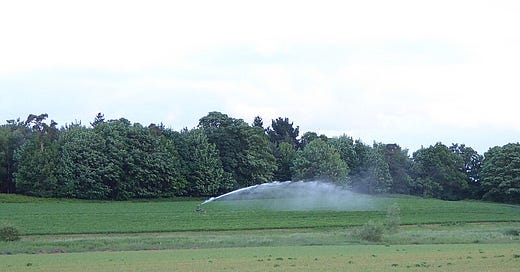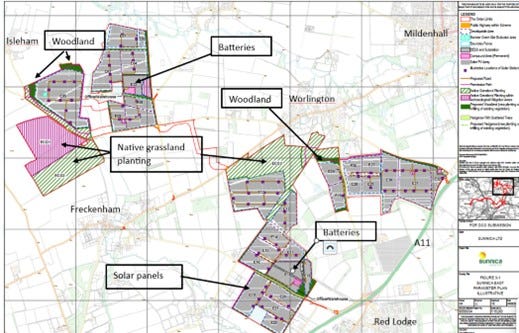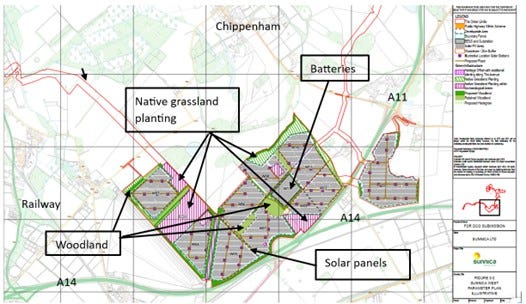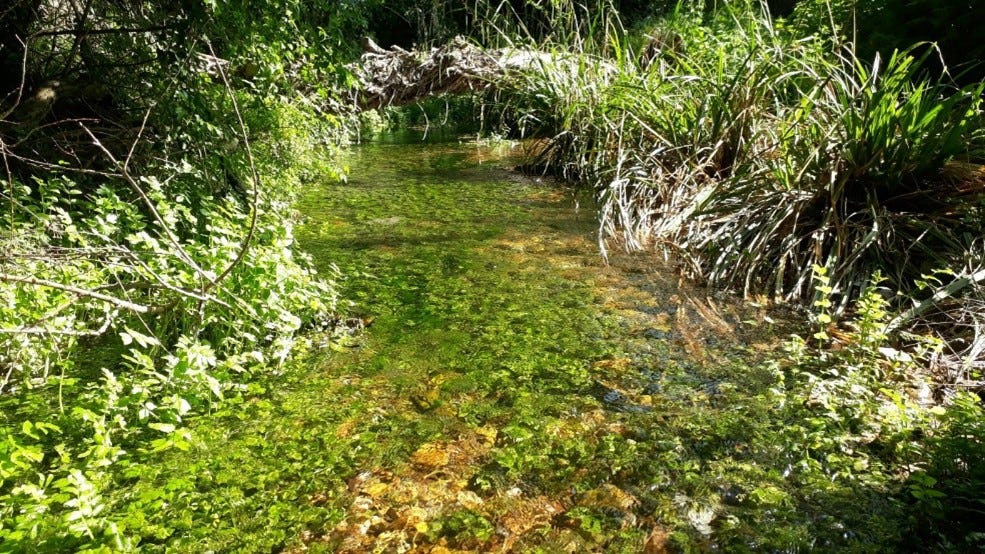A lot seems to have happened in the last month.
Thankfully we now have a government that has a clear mission to “make Britain a clean energy superpower” and is in a hurry to get things done. It turns out Starmer isn’t just “a decent man,” but a tough former Director of Public Prosecutions, with a massive majority in parliament and a cabinet full of ministers that actually know what they’re talking about.
This is undoubtedly what we need to tackle the looming threat of catastrophic climate change, but inevitably there will be disagreement about what to “get done”, and how.
We’ve already seen the ban on onshore wind overturned and the approval of the massive Sunnica solar farm between Mildenhall and Newmarket.
Sunnica East (annotations by CNC)
Sunnica West (annotations by CNC)
This will generate around 500MW, which is enough to decarbonise the electricity supply for roughly 3 times the population of Cambridge, or 2/3rds the population of Cambridgeshire.
The Sunnica decision is a classic example of the dilemmas of government. We clearly need a lot more solar and wind power in order to decarbonise our economy. However, the local residents are understandably concerned about the impact on their local landscape and views.
Many of us would prefer to see smaller, community owned energy projects and solar panels on roofs, such as the ~1000m2 on Kings College Chapel in Cambridge or the impressive ~3000m2 BigSolar.coop scheme at Eco-pak in Chatteris.
Rooftop solar at Eco-pak, Chatteris.
However, the reality is that if we want to decarbonise fast and reduce bills as much as possible, we’ll need big ground based projects too. To put things in proportion, the Sunnica project will be around 1000 times bigger than Eco-pak, which was itself BigSolar.coop’s biggest ever project. (By the way, to help the BigSolar co-op do more rooftop solar projects like the Eco-pak one, do participate in their share offer here)
Although much of the opposition to the Sunnica project focussed on the importance of agriculture, by the time of the decision, only one of the local farmers opposed the project. This may be because the scheme is now slightly smaller than originally proposed and mostly only on moderate quality farmland. And, as the Examining Authority’s report pointed out, because the land is mostly “droughty” and stony chalk, good yields can only be achieved with irrigation: the limiting factor for farming is the availability of water, not land.
Given the dire state of our chalk streams and the depletion of the chalk aquifer, we wonder: could the Sunnica solar farm help save the Chalk Streams, both by reducing irrigation and by the Local Authority requiring them to capture the rain falling on the panels? And, if the scheme is done right (which they often aren’t) local soil health, habitats and biodiversity should all improve by being released from intensive agriculture for 40 years
Hoffers Brook Chalk Stream
The West Suffolk Council leader Cliff Waterman has commented in the Cambridge Independent, that although they are considering whether to challenge the decision, “if the development must go ahead, we must be ready to reap the benefits for employment, business rates and economic development”
We’d add Climate, Chalk streams and Biodiversity to the list, but this seems to us to be a very productive attitude.







